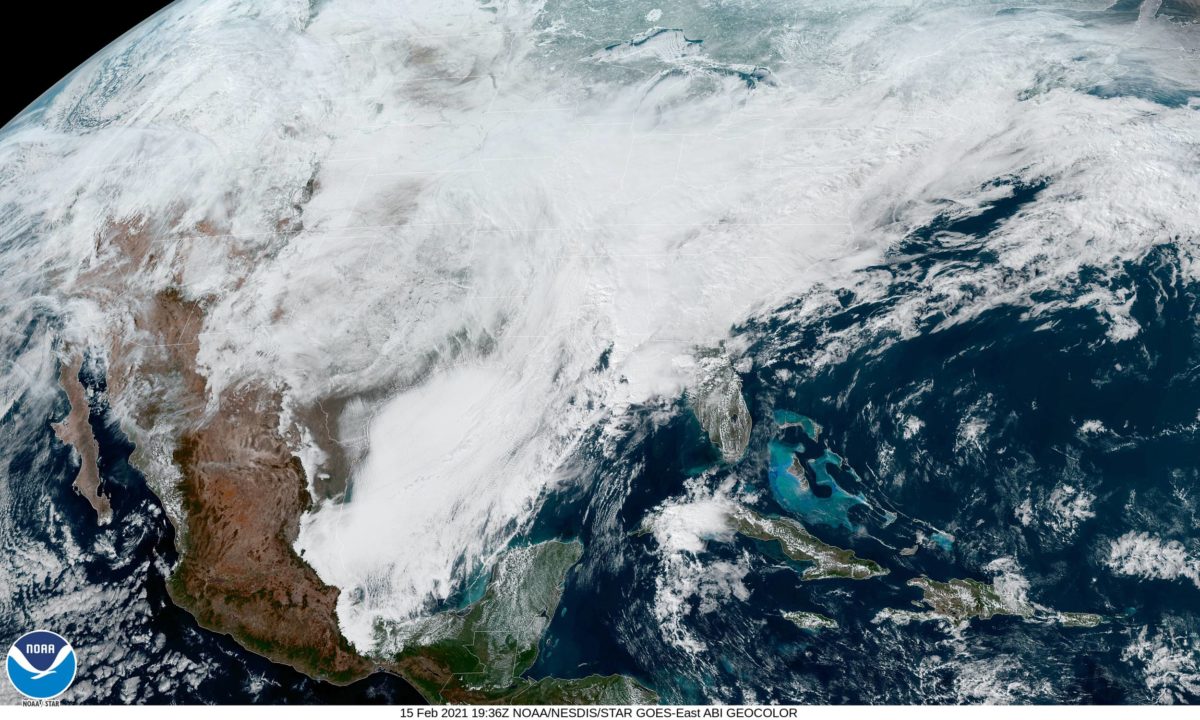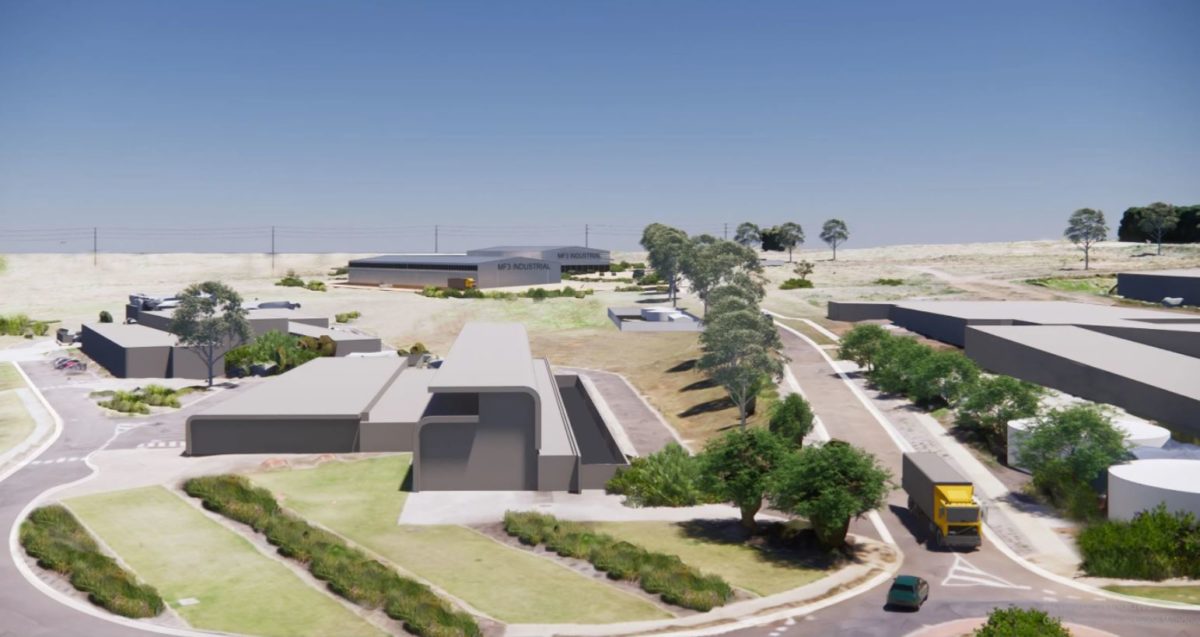https://pv-magazine-usa.com/2022/05/13/climate-the-texas-grid-and-solar-batteries-to-the-rescue/
Climate, the Texas grid, and solar + batteries to the rescue

The February 2021 winter storm Uri over Texas.
Image: NOAA
In 2021, winter storm Uri became a landmark example of the unpredictability of climate, and its harsh impact on the legally mandated core requirements of electric utility companies: to provide electricity reliably, and to furnish just and reasonable prices to customers.
The electric grid’s functional collapse during the storm was an example of the Texas ERCOT grid’s failure of achieving those mandated goals. By some estimates, the storm caused $130 billion in near-term economic damages, and the long-term consequences have not yet been fully assessed.
The sudden spike in unplanned-for energy demand caused by extreme weather led to wholesale market spot prices skyrocketing up to $9,000/MW, and that price held for over three days. Historically, the price cap is only hit momentarily, and pressures are relieved quickly, but this storm was described as a “tail event” that caused unusual levels of strain on the grid.
This was caused by a combination of nonfunctioning natural gas equipment, and congestion on the grid from intense localized energy demand, that caused substations to cut power to stabilize the grid. A study by the Federal Energy Regulatory Commission found 87% of the outages were caused by issues with natural gas supply as uninsulated stations failed to function.
However, was winter storm Uri really a “tail event?”
Commenting on the concept at the RE+ conference in San Antonio, Solar Energy Industries Association (SEIA) president and CEO Abigail Ross Hopper said, “The past as a model for the future is not true anymore. One hundred-year storms occur every five years. What is normal? What is baseline?”
The panel Hopper led at RE+ on the ERCOT grid shared that 40,000 power outage events occurred in the US last year. That is a 50% year-over-year increase over 2020.
The figures highlight two problems. First, the centralized grid is failing the people who rely on it. Second, the climate is adding more pressures that will need to be dealt with to keep these systems running adequately.
Two key modes of thinking related to climate response are mitigation and adaptation. Mitigation is fighting the source of climate change itself, which for the energy sector means phasing out fossil fuels and increasing the use of non-emitting energy sources. Adaptation relates to adjusting the way we operate to recognize changes on the Earth and better prepare for those changes. Solar and batteries can help with both.
Mitigation
A lot of climate talk is centered around mitigation. At the RE+ conference, the Smart Electric Power Alliance (SEPA) shared that 70% of utilities have a 100% clean energy goal. The White House has also set goals for 100% carbon-free energy by 2035. The less carbon emitted, the more we can stave off the worst effects of climate change.
This is one of the main reasons we see the ERCOT project queues full of solar projects. PV projects with signed interconnection agreements with expected commercial operations dates through 2024 total over 9.1 GW in capacity.

Adaptation
The other element of climate response, adaptation, is coming increasingly under focus as the international community fails to coherently cooperate on mitigation efforts.
This is where energy storage comes into play, and where intelligent planning of the grid is critical. At RE+ San Antonio, residential installer Sunrun shared that its home battery systems provided 234,000 hours of backup power following winter storm Uri. Interest in batteries skyrocketed, with hits on Sunrun’s battery-related website pages increasing 350% in the direct aftermath. This backup was about more than just comfort, but also about safety. Uri took an estimated 246 lives of Texans.
The financial costs of such events are massive, too, and retail energy providers who did not properly hedge against the risks of the volatile ERCOT wholesale market were hit with fees so sharp they went out of business overnight. Homeowners in predatory contracts were also exposed directly to the wholesale market, and many were faced with multi-thousand-dollar utility bills.
As explained above, congestion on the grid was a key cause of the problem. Delivering power from generation centers in remote places across long distances to load centers in large cities often runs into bottlenecks, leading to curtailment and scheduled blackouts.

Unfortunately, this congestion problem might worsen due to the way that solar and wind energy are being deployed across Texas’ ERCOT grid.
A vast bulk of the large-scale solar projects are in the western, sunnier part of Texas, and are delivered to population centers in the east. The issue can be looked at as a microcosm of the entire United States, where legislators are suggesting building a transmission superhighway from the west to the eastern seaboard.

Image: ERCOT
Congestion rents, or the cost of transmission services, are expected to worsen in many areas across ERCOT, despite hundreds of millions of dollars planned to build transmission to alleviate the congestion.
Solar and batteries to the rescue
Solar and batteries can serve a critical role in alleviating this congestion, reducing renewables curtailment, smoothing the curve of wholesale market demand spikes, and providing critical backup power in times of crisis.
When located closer to load centers, or the location of energy demand, batteries can readily dispatch backup power. By locating the batteries as “nodes” further down the grid, pressure is taken off key bottlenecks like substations, which shut down in times of extreme peak demand, and are extremely expensive to upgrade.
Batteries can also serve as peak-demand shavers, avoiding those massive spikes in wholesale market volatility. This is the main way they are currently deployed in ERCOT, and peak demand shaving represents a massive market opportunity. At RE+ utility-scale solar and storage developer 8-minute energy shared that 95% of the revenue generated by a two-hour duration battery is earned in the first hour of dispatch. 8minute said the market opportunities for batteries could be improved, if “predefined revenue streams” are created, like in the capacity-based, forward looking market of California’s CAISO grid.
Ali Chowdhury, vice president of transmission and interconnection at 8minute shared that there is a lot of uncertainty in the planning of transmission buildout, which has been hampering the buildout of solar. He said transmission can take at least five to ten years to build, and ERCOT is at a standstill in the financial planning process.
Meanwhile, distributed battery energy storage can be dispatched quite quickly. Considering the mounting pressures on the Texas grid, and of the United States at large, a strategy of deploying distributed solar and battery energy storage may be the best strategy at hand for both climate mitigation and adaptation.
Jason O’Leary, Principal Analyst at pv-intel.com, contributed to this article with data analysis and data visualization.
This content is protected by copyright and may not be reused. If you want to cooperate with us and would like to reuse some of our content, please contact: editors@pv-magazine.com.




